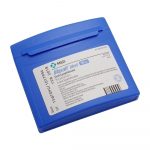
Contents
rocuronium
Rocuronium is a medication used to produce skeletal muscle relaxation, as an adjunct to general anesthesia during surgical procedures, mechanical ventilation, and rapid sequence and routine tracheal intubation. Different drugs are administered during general anesthesia to produce loss of consciousness and pain relief, as well as muscle relaxants to prevent muscle contractions that can interfere with treatment.
Rocuronium is a nondepolarizing neuromuscular blocker that relaxes skeletal muscles by blocking acetylcholine activity. Acetylcholine is a neurotransmitter released by neurons at the neuromuscular junction to make muscles contract. Rocuronium competes with acetylcholine to bind to cholinergic receptors on the motor end-plate, preventing muscle contraction. Its effects can be reversed with medications that enhance acetylcholine levels.
Rocuronium has a rapid to intermediate onset of action and intermediate duration of effects. It is approved for use in rapid sequence intubation, a set of procedures for safe and quick intubation and anesthesia induction.
Warnings
- Do not use rocuronium in patients with known hypersensitivity reactions to rocuronium or other neuromuscular blocking agents.
- Administer rocuronium only in a setting where facilities for intubation and mechanical ventilation with oxygen, and drugs to counter rocuronium’s effects swiftly are readily available.
- Exercise particular care when administering rocuronium to patients with a history of anaphylactic reactions to other neuromuscular blocking agents.
- Do not extubate patients until they have recovered sufficient neuromuscular function.
- Consider use of reversal agents in patients at a higher risk for residual paralysis.
- Tolerance and resistance to rocuronium may develop in patients with prolonged use in the ICU.
- During rocuronium administration and recovery, monitor neuromuscular transmission continuously with a peripheral nerve stimulator.
- Do not administer additional rocuronium doses if a definite response to nerve stimulation is not present.
- Prolonged use of neuromuscular blocking agents with or without corticosteroids can result in prolonged paralysis and/or skeletal muscle weakness during initial attempts to wean off mechanical ventilators.
- In weak and debilitated patients, and in patients with metastatic cancer (carcinomatosis) or neuromuscular diseases
- With the use of certain inhalation anesthetics, antibiotics, magnesium salts, lithium, local anesthetics, procainamide, and quinidine.
- Recovery may be delayed or difficult in such patients, consider using a lower than recommended initial dose of rocuronium.
What are the side effects of rocuronium?
Common side effects of rocuronium include transient low blood pressure (hypotension) and transient high blood pressure (hypertension). Less common side effects include nausea, vomiting, abnormal electrocardiogram readings, rapid heart rate, irregular heart rhythm, hiccup, asthma, bronchospasm, wheezing, abnormal breathing sounds, injection site swelling, rash, itching, severe allergic reactions, and shock.
Call your doctor immediately if you experience any of the following symptoms or serious side effects while using this drug:
- Serious heart symptoms include fast or pounding heartbeats, fluttering in your chest, shortness of breath, and sudden dizziness;
- Severe headache, confusion, slurred speech, severe weakness, vomiting, loss of coordination, feeling unsteady;
- Severe nervous system reaction with very stiff muscles, high fever, sweating, confusion, fast or uneven heartbeats, tremors, and feeling like you might pass out; or
- Serious eye symptoms include blurred vision, tunnel vision, eye pain or swelling, or seeing halos around lights.
This is not a complete list of all side effects or adverse reactions that may occur from the use of this drug. Call your doctor for medical advice about serious side effects or adverse reactions. You may also report side effects or health problems to the FDA at 1-800-FDA-1088.
What is the dosage for rocuronium?
Injectable solution
- 10 mg/mL (5 and 10 mL vials)
Adult:
Rapid Sequence Intubation
- 0.6-1.2 mg/kg intravenous (IV)
Tracheal Intubation
- 0.45-0.6 mg/kg IV
- Maintenance: 0.1-0.2 mg/kg IV repeat as needed OR
- Continuous infusion: 0.01-0.012 mg/kg/minute IV
Administration
- Dose should be calculated based on ideal body weight
Pediatric:
Tracheal Intubation
Children below 3 months
- Safety and efficacy not established
Children 3 months to 14 years
- Initial: 0.6 mg/kg IV
- Maintenance: 0.075-0.125 mg/kg IV OR
- Continuous infusion: 0.012 mcg/kg/minute (IV)
Children above 14 years
- 0.45-0.6 mg/kg IV
- Maintenance: 0.1-0.2 mg/kg IV repeat as needed OR
- Continuous infusion: 0.01-0.012 mg/kg/minute IV
Overdose
- Rocuronium overdose can cause prolonged neuromuscular blockade lasting longer than the duration required for anesthesia and surgery.
- Primary treatment for rocuronium overdose is maintenance of a patent airway, controlled ventilation, and adequate sedation until the patient recovers normal neuromuscular function.
- Once there is evidence of recovery from neuromuscular blockade, further recovery can be facilitated by the use of an anticholinesterase drug in combination with an appropriate anticholinergic agent.
- Do not administer anticholinesterase drugs before spontaneous recovery from neuromuscular blockade begins to some extent.
- Monitor recovery from neuromuscular blockade with a peripheral nerve stimulator and support ventilation until spontaneous breathing is established.
- Onset of recovery from neuromuscular blockade may be delayed in debilitated and weakened patients, patients with metastatic cancer (carcinomatosis), and with the use of certain drugs that can enhance neuromuscular block or cause respiratory depression. Manage such patients with appropriate care.
What drugs interact with rocuronium?
Inform your doctor of all medications you are currently taking, who can advise you on any possible drug interactions. Never begin taking, suddenly discontinue, or change the dosage of any medication without your doctor’s recommendation.
- Rocuronium has no listed severe interactions with other drugs.
- Rocuronium has serious interactions with at least 29 different drugs.
- Rocuronium has moderate interactions with at least 112 different drugs.
- Rocuronium has mild interactions with at least 37 different drugs.
The drug interactions listed above are not all of the possible interactions or adverse effects. For more information on drug interactions, visit the RxList Drug Interaction Checker.
It is important to always tell your doctor, pharmacist, or health care provider of all prescription and over-the-counter medications you use, as well as the dosage for each, and keep a list of the information. Check with your doctor or health care provider if you have any questions about the medication.
Pregnancy and breastfeeding
- Animal reproductive studies with rocuronium did not show evidence of fetal harm. High doses of rocuronium in nonventilated rats caused respiratory dysfunction, but this is not relevant to humans as patients are always ventilated to prevent oxygen deficiency.
- There are no adequate and well-controlled studies on the use of rocuronium in pregnant women. Use during pregnancy should be restricted only when necessary.
- Based on the use of rocuronium during Cesarean section in a limited number of women, rocuronium is not indicated for rapid sequence induction for anesthesia in women undergoing Cesarean section.
- There is no information on the presence of rocuronium in breastmilk or its effects on the breastfed infant.
By clicking Submit, I agree to the MedicineNet’s Terms & Conditions & Privacy Policy and understand that I may opt out of MedicineNet’s subscriptions at any time.
Summary
Rocuronium is a medication used to produce skeletal muscle relaxation, as an adjunct to general anesthesia during surgical procedures, mechanical ventilation, and rapid sequence and routine tracheal intubation. Common side effects of rocuronium include transient low blood pressure (hypotension) and transient high blood pressure (hypertension). Consult your doctor if pregnant or breastfeeding.


